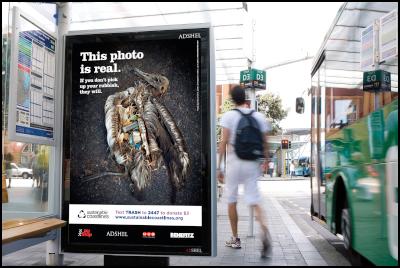Rubbish Campaign Shows Birds Have Had A Guts-Full
Rubbish Campaign Shows Sea Birds Have Had A Guts-Full

TUESDAY 17 AUGUST – The dynamic kiwi charity Sustainable Coastlines today launched a hard-hitting campaign aimed at raising awareness around the truly shocking effects of litter that makes it onto our beaches and into our oceans. The campaign – which features a disturbing photo of the decomposing remains of a bird: its stomach filled with pieces of plastic – is certain to get people talking.
“The bottle caps, cigarette lighters, drinking straws and all other manner of disposable plastic products that we drop on our streets can very quickly end up out at sea and on our beaches” says the charity’s Marketing Manager Camden Howitt. “Once trash gets into coastal and marine environments it can have devastating effects on the wildlife. This image will challenge the way that people think about and deal with their rubbish.” The photo used in the campaign was taken on Midway Atoll – a tiny set of sandy islets in the northwestern Hawaiian Islands thousands of kilometres from the nearest continent. Hawaiian monk seals, green sea turtles and spinner dolphins frequent the stunning turquoise waters of this remote atoll, and almost two million seabirds – including the world’s largest breeding population of the majestic Laysan albatross - breed and feed their young there each year.
But the albatrosses are dying, the oceans are polluted, and the atoll is strewn with plastic and the rotting carcasses of choked seabirds. Aside from the usual mash of squid and fish eggs, nesting albatross chicks here are fed a cocktail of rubbish by their parents, who mistake the plastic pieces as food. The sheer volume of plastics in the chicks’ stomachs leaves little room for food and many die of starvation. What’s left in the decomposing albatross carcasses resembles what you’d expect to find in a rubbish bin, landfill or, as Sustainable Coastlines points out, an urban drain.
They exposed the effect of litter in our drains by cleaning up the city-facing side of Aotea/Great Barrier Island over two events a year apart. They proved that many tonnes of plastic rubbish flow out of Auckland City on a continuous basis in the prevailing sou-westerly wind as more rubbish was removed in the second year’s event. They continue to work on large-scale events alongside such hard-hitting media campaigns to raise awareness in the community about marine debris, pointing out that the challenge is very real on New Zealand shores too- in 2008 a Royal albatross was found dead on Taiaroa Head in Dunedin with 272 pieces of plastic in its’ stomach.
It seems that their simple message is being adopted widely, as New Zealanders look to protect their beloved coastlines. Adshel sponsored the charity the media space, while Pitstop, HVG and Benefitz contributed to make the campaign possible.
An incredible line-up of performers is supporting the charity for a fundraising ball on the 18th of September at the Hilton Auckland. New Zealand’s top concert pianist, Michael Houstoun, will be performing, as well as the sensational Hollie Smith, jazz legends the Nairobi Trio and newcomer Bella Kalolo- who is currently nominated as best female vocalist for the Pacific Music Awards.
Sustainable Coastlines are calling for donations to help fund their ongoing work on projects to sustain and protect coastlines around New Zealand and around the world. Supporters can make a $3 donation towards their work by simply texting TRASH to 2447,
ENDS


 Gordon Campbell: On Why We Can’t Survive Two More Years Of This
Gordon Campbell: On Why We Can’t Survive Two More Years Of This Lady Tureiti Moxon: Honouring Kahurangi Tariana Turia - A Legacy of Courage, Leadership, and Tino Rangatiratanga
Lady Tureiti Moxon: Honouring Kahurangi Tariana Turia - A Legacy of Courage, Leadership, and Tino Rangatiratanga Biosecurity NZ: Biosecurity NZ Investigating And Boosting Trapping After Auckland Fruit Fly Find
Biosecurity NZ: Biosecurity NZ Investigating And Boosting Trapping After Auckland Fruit Fly Find NZ Customs Service: New Year Begins With Customs Arrests For Three Alleged Drug Couriers
NZ Customs Service: New Year Begins With Customs Arrests For Three Alleged Drug Couriers Helen Leahy: Honourable Dr Dame Tariana Turia
Helen Leahy: Honourable Dr Dame Tariana Turia Animal Justice Party: Major Brands Linked To Alleged Widespread Animal Cruelty In New Zealand Wool Industry
Animal Justice Party: Major Brands Linked To Alleged Widespread Animal Cruelty In New Zealand Wool Industry NZ Police: Police officer killed following an incident in Nelson
NZ Police: Police officer killed following an incident in Nelson


